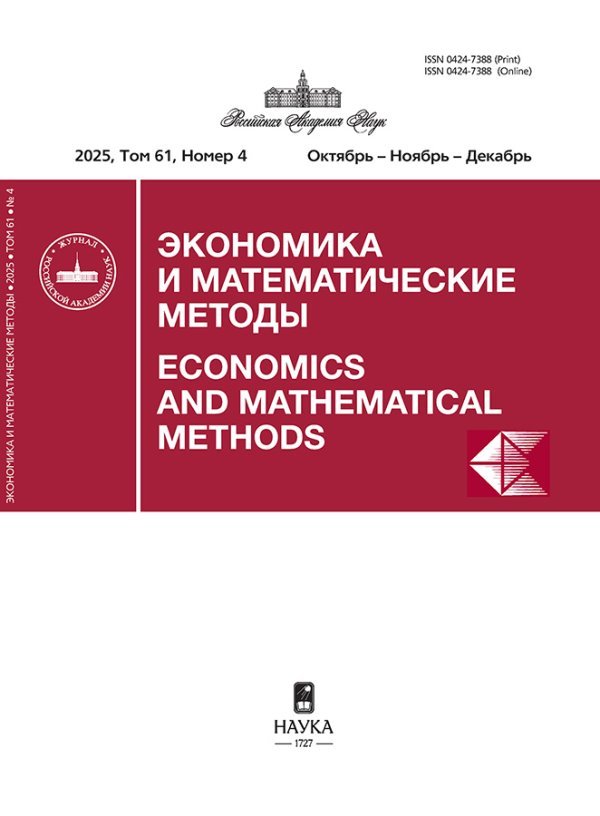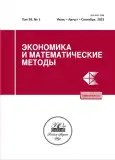Analysis of marginalism. Part 2
- Authors: Wu J.1,2, Makarov V.L.3,4,5, Bakhtizin A.R.6, Wu Z.7
-
Affiliations:
- Guangzhou Milestone Software Co., Ltd.
- National Simulation and Control Engineering Technology Research Center
- ЦЭМИ РАН
- Российская экономическая школа
- Высшей школы государственного администрирования МГУ имени М.В. Ломоносова
- Central economic and mathematical Institute of the Russian Academy of Sciences
- Guangzhou Milestone Software Co.
- Issue: Vol 59, No 3 (2023)
- Pages: 31-41
- Section: Articles
- URL: https://gynecology.orscience.ru/0424-7388/article/view/653323
- DOI: https://doi.org/10.31857/S042473880026984-1
- ID: 653323
Cite item
Abstract
In recent years, based on the traditional theory of value — the labor theory of value and the theory of surplus value, as well as the hypothesis of Jevons, Tesla and Foley, — Chinese and Russian scholars have further adopted the mathematical paradigm of theoretical mechanics for reference to establish a mathematical model system for economics, which is called the New theory of value. Compatible with the traditional theory of value, the new theory of value puts forward the idea that the value depends on the force of labor expended in the process of commodity production, and the value appreciation depends on the labor gravitational force generated by the improving dexterity of workmen. That is to say, during the process of production, constant capital and variable capital as kinetic energy and potential energy of value, convert into each other under the value conservation theorem, playing a dominate role in generating value and surplus value of products. In addition, the law of diminishing marginal utility is not an axiom, but a special economic law under unbalanced supply and demand. Obviously, these theoretical conclusions are of great significance, which not only make the traditional theory of value a self-consistent logical system, but also complete the New theory of value by absorbing the rational components from both the classical economics based on the labor theory of value and the theory of surplus value, and the neoclassical economics based on the law of diminishing marginal utility. In this paper, we will analyze this problem by investigating the origin of the law of diminishing marginal utility.
About the authors
Jie Wu
Guangzhou Milestone Software Co., Ltd.; National Simulation and Control Engineering Technology Research Center
Email: jw@gzmss.com
Guangzhou, China
Valery Leonidovich Makarov
ЦЭМИ РАН; Российская экономическая школа; Высшей школы государственного администрирования МГУ имени М.В. Ломоносова
Email: makarov@cemi.rssi.ru
Russian Federation
Albert Raufovich Bakhtizin
Central economic and mathematical Institute of the Russian Academy of Sciences
Email: albert.bakhtizin@gmail.com
Russian Federation
Zili Wu
Guangzhou Milestone Software Co.
Author for correspondence.
Email: wzl@gzmss.com
China
References
- Wu J., Makarov V.L., Bakhtizin A.R., Wu Z. et al. (2020). The new theory of value // Экономика и математические методы. Т. 56. № 4. С. 5–19.
- Aristotle (1999). Politics, translated by Benjamin Jowett. Kichener: Batoche Books.
- Arrow K.J. (1951). Social choice and individual values. 2nd ed. N.Y.: John Wiley & Sons. Re-printed by New Heaven, CT: Cowles Foundation, Yale University in 1970.
- Arrow K.J., Debreu G. (1954). Existence of an equilibrium for a competitive economy. Econome-trica, 22, 3, 265–290.
- Bai B. (2006). Research on value transformation problem. Peking: The Commercial Press.
- Bortkiewicz L. von (1949). On the correction of Marx's fundamental theoretical construction in the third volume of capital. Appendix. Clifton: A.M. Kelly. Originally published in 1907.
- Bortkiewicz L. von (1952). Value and price in the Marxian system. Transl. by Kahane J. Interna-tional Economic Papers, 2, 36–51. Originally published in 1906–1907.
- Böhm-Bawerk E. von (1896). Karl Marx and the close of his system. London: T.F. Unwin.
- Chen X., Wang B. (2020). Space of Ricci flows (II). Part B: Weak compactness of the flows. J. Differential Geom., 116 (1), 1–123 (September). doi: 10.4310/jdg/1599271253
- Debreu G. (1959). Theory of value: An axiomatic study of economic equilibrium. N.Y.: John Wiley & Sons.
- Ding B. (2012). On Samuelson's criticism of the labour theory of value. Social Sciences in China, 2, 79–93.
- Engels F. (1947). Anti-Duhring: Herr Eugen Duhring's revolution in science. Moscow: Progress Publishers. Originally published in 1878.
- Marx K. (1867). Das Kapital. Vol. I. Hamburg: Verlag von Otto Meissner. (Transl. from the German in: “Marx and Engels. Collected works (Vol. I)”. Vol. 35. London: Lawrence & Wishart in 1996.)
- Marx K. (1894). Das Kapital. Kritik der Politischen Ökonomie. Vol. III. Hamburg: Otto Meissners. (Transl. from the German in: “Marx and Engels. Collected works (Vol. III)”. Vol. 37. London: Lawrence & Wishart in 1996.)
- Meek R. (1956a). Studies in the labour theory of value. London: Lawrence and Wishart.
- Meek R. (1956b). Some notes on the transformation problem. Economic Journal, 66, 261, March.
- Meek R. (1961). Mr. Sraffa's rehabilitation of classical economics. Scottish Journal of Political Economy, Scottish Economic Society, 8 (2), June, 119–136.
- Morishima M. (1973). Marx's economics. Cambridge: Cambridge University Press.
- Morishima M. (1974a). Marx in the light of modern economic theory. Econometrica, 42, 611–633.
- Morishima M. (1974b). The fundamental Marxian theorem: a Reply to Samuelson. Journal of Economic Literature, 12 (1), 71–74.
- Qian X., Yu J., Dai R. (1990). A new discipline of science — the Study of open complex giant system and its methodology. Chinese Journal of Nature, 13 (1), 3–10.
- Ricardo D. (1817). On the principles of political economy and taxation. London: John Murray. (Reprinted by Kitchener: Batoche Books in 2001.)
- Say J.-B. (1803). Traité d'économie politique: ou Simple exposition de la manière dont se forment, se distribuent, et se consomment. Paris. (Transl. and reprinted from French by C.R. Prinsep “A treatise on political economy; or the production, distribution and consumption of wealth”. N.Y.: Augusts M. Kelley Publishers in 1971.)
- Seton F. (1957). The transformation problem. Review of Economic Studies, 24, 3, 149–160.
- Smith A. (1776). An inquiry into the nature and causes of the wealth of nations. London: Printed for W. Strahan; and T. Cadell. (Reprinted by New York: Random House in 1994.)
- Sraffa P. (1960). Production of commodities by means of commodities — a prelude to a critique of economic theory. Cambridge: Cambridge University Press.
- Sweezy P. (1942). The theory of capitalist development. New York: Monthly Review Press.
- Sweezy P. (1949). Karl Marx and the close of his system. New York: Augustus Kelly.
- Wang J., Wang T., Shi Y., Xu D., Chen Y., Wu J. (2022). Metaverse, SED model and new theory of value. Complexity. Article ID 4771516. 26 p. doi: 10.1155/2022/4771516
- Wieser F. (1889). Natural value. Transl. and reprinted by Ch.A. Malloch. London, New York: Au-gustus M. Kelley Publishers, Macmillan and Co.
- Winternitzv J. (1948). Value and prices: A solution of the so-called transformation problem. Eco-nomic Journal, 58, 230, June, 276–280.
- Wu J. (1999a). On the causes of commodity price and market equilibrium at the critical point of price (I). The Journal of Quantitative & Technical Economics, 7, 21–28.
- Wu J. (1999b). On the causes of commodity price and market equilibrium at the critical point of price (II). The Journal of Quantitative & Technical Economics, 8, 40–47.
- Wu J., Qin Y. (2008). Commodity exchange model based on Marxist economics. The Journal of Quantitative & Technical Economics, 2, 149–160.
- Wu J. (2012). On wealth. Vol. I–II. Peking: Peking University Press.
- Wu J., Wu Z. (2021). Analysis of market equilibrium based on the new theory of value. SCIREA Journal of Economics, 6 (4), 71–113. doi: 10.54647/economics79260
- Zhang Z. (2001). The final solution to the transformation problem. The Journal of Quantitative & Technical Economics, 18 (2), 4.
- Zhang Z. (2004). Solving the centennial problem. Peking: People’s Publishing House.
Supplementary files








